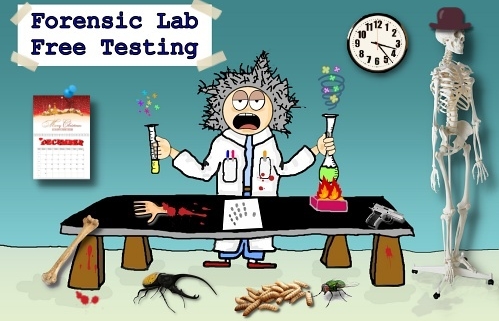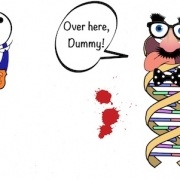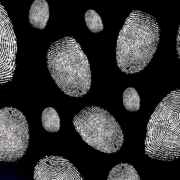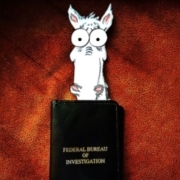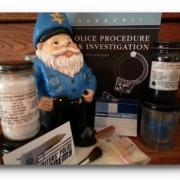The FBI’s Forensic Laboratory: Evidence Collection and Requests for Submissions
The FBI’s forensic laboratory is one of the largest in the world, and its services and capabilities are far-reaching. You name it and they’ve got it. You need it and they can do it. To sweeten the pot, their services, examinations, testings, and expert courtroom testimonies are free to all FBI field offices, U.S. attorneys, the U.S. military, all other federal agencies, and state, county, and municipal law enforcement agencies, including those in U.S. territories.
Of course, there are limitations and exceptions. For example, the FBI laboratory does not accept requests for service in civil matters unless the request is from a federal agency. Nor will they accept requests for service from private citizens or non-governmental agencies (private investigators, etc.).
There is a process required for sending evidence to the FBI laboratory for examination/testing, and the procedure is not as simple as mailing Aunt Betty Lou’s annual birthday card. Instead, depending upon the items(s) and their nature, the FBI lab, like all forensic laboratories, has specific guidelines that must be followed.
Per the FBI, all requests for evidence examinations should be in writing, complete with official department letterhead. The request must be addressed to the FBI Laboratory Evidence Management Program, unless otherwise indicated in the Examinations section (see below for examples).
Each request for evidence examinations/testing must contain:
- The submitting contact person’s name, agency, address, and telephone number;
- Previous case-identification numbers, evidence submissions, and communications relating to the case;
- Description of the nature and the basic facts of the case as they pertain to evidence examinations;
- The name(s) of and descriptive data about the individual(s) involved (subject, suspect, victim, or a combination of those categories) and the agency-assigned, case-identification number;
- The violation associated with the evidence;
- If requested, the need for expedited examination
- Name of the relevant prosecutor’s office or prosecutor assigned, if available;
A list of the evidence being submitted and a copy of the letter should be included in all containers in which evidence has been shipped to the laboratory. The letter should be placed in a separate envelope within the shipping container.
Other items to be included in an official request:
- What type(s) of examination(s) is/are requested;
- Where the evidence should be returned and where the Laboratory report should be sent—street address and phone number.
Collection and packaging evidence
Packaging and collection methods vary depending upon the type and nature of evidence.
For example:
Anthropological Examinations

Anthropological examinations involve the analysis of skeletal remains (or potential skeletal remains). Laboratory testing can result in the determination, interpretation, or estimation of whether the evidence is skeletal (bone or tooth) versus a material other than bone. Scientists can also determine whether bones are human or non-human, if the bones submitted are from more than one person, and the age of the bones—present day or ancient.
Biological information obtained from certain bones could indicate age, sex, ancestry, and size (height and weight of the person when alive). It’s possible to determine the manner of death if by trauma—projectile, blunt or edged weapon, such as by knife, sword, ax, etc. And, of course, identification of the victim by comparison to medical records and DNA.
FBI forensic anthropologists are available to assist in the detection and recovery of remains, if needed.
Collection and packaging of anthropological evidence
Collect bones (or small bone assemblages) individually in paper bags or other breathable material. Aluminum foil may be shaped and formed around burned or fragile bones. Sealed plastic packaging may be acceptable for remains with fresh/wet tissue, an exception to the typical “wet evidence in paper container” rule. Include cold packs and/or ‘Biohazard’ stickers. Place stabilizing material inside the container—bubble wrap, etc.– to prevent movement of contents which could damage bone material.
Bullet Examinations
A fired bullet can be examined to determine weight, caliber, and rifling characteristics (GRCs). GRCs are the number, width, and direction of twist of the rifling grooves imprinted on a fired bullet as it passes through the barrel of a firearm. Scientists conduct microscopic examinations of submitted bullets to determine if any distinctive marks of value are present.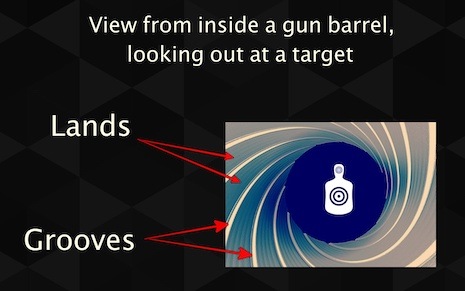 If investigators submit a suspected firearm a comparison is done between a bullet fired from the weapon and the bullet in question. A match determines the that firearm is indeed the one used in the crime.
If investigators submit a suspected firearm a comparison is done between a bullet fired from the weapon and the bullet in question. A match determines the that firearm is indeed the one used in the crime.
If a suspect firearm is not available to submit as evidence (not located, etc.), examiners compare the fired bullet to those in the FBI Laboratory’s GRC database, which could produce a match to a firearm that could have fired the round.
When examining fired bullets, and when comparing them to known samples (bullets test-fired from suspect’s weapon and compared to round found at the scene or inside a body), investigators and/or scientists should record the following information.
- Caliber/gauge
- Bullet/slug weight
- The number of land and grooves
- Direction of twist
- Width of lands
- Width of grooves
- Bullet diameter.
- Composition of bullet.
- Style.
- Manufacturer/marketer of bullet/projectile. If applicable, use reference materials such as an ammunition database.
- Detailed description of the bullet.
- Note type and position of cannelures.
- Note any foreign/extraneous markings—shave marks, flared base, etc.
- If possible, compare marks on bullets with tests from a firearm or with other bullets.
Click this link to read more about USING LANDS AND GROOVES TO SOLVE MURDERS
Collection and packaging of bullets
Package bullets to prevent contact with other bullets.
Hand delivery of bullets is not a requirement. Instead, they can be sent to the FBI lab via Registered Mail through the U.S. Postal Service. Evidence must be packaged separately and identified by date, time, location, collector’s name, case number, and evidence number. It is important to not mark bullets or other firearm-related evidence. Dates, times, location found, evidence collector’s name, case and evidence number must be on the package containing the evidence (bullets).
Bullet v. Ammunition – There is a Difference!
Bullet – an elongated missile of some type (lead, etc.) that’s to be fired from a firearm. A bullet is one part of a complete round of ammunition.
From ATF – Bureau of Alcohol, Tobacco, Firearms and Explosives:
Gun Control Act Definitions
Ammunition
The term “Ammunition” means ammunition or cartridge cases, primers, bullets, or propellant powder designed for use in any firearm.
The term shall not include (a) any shotgun shot or pellet not designed for use as the single, complete projectile load for one shotgun hull or casing, nor (b) any unloaded, non-metallic shotgun hull or casing not having a primer.
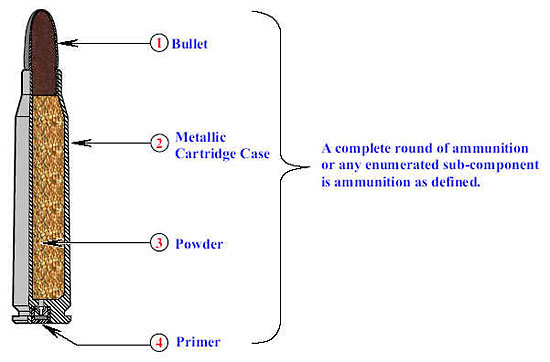
ATF image
USPS – Shipping Ammunition
The United States Postal Service prohibits sending live ammunition through the U.S. mail. FYI – Also not allowed to be shipped through U.S. mail are:
- Air Bags
- Ammunition
- Explosives
- Gasoline
- Marijuana (medical or otherwise); hemp/CBD is allowed, but restricted
And, for fun, here are other items that are prohibited by the USPS:
- Arsenic
- Asphalt at or above its flashpoint
- Bombs of any type
- Grenades
- Hydrogen peroxide stabilized, or Hydrogen peroxide aqueous solutions, stabilized with more than 60 percent hydrogen peroxide.
Hydrogen peroxide, in its pure form, is a pale blue liquid. When diluted water (3–6% by weight) its used by consumers as an oxidizer, bleaching agent, and as an antiseptic. Concentrated hydrogen peroxide, or “high-test peroxide”; however, decomposes explosively when heated and can and has been used as rocket propellant.
UPS and FedEX accept packages containing ammunition
The following is from the UPS website.
UPS – How to Ship Ammunition (Cartridges, Small Arms)
UPS accepts for transportation such ammunition as constitutes “cartridges, small arms,” as defined in 49 C.F.R. § 173.59. All other allowable ammunition shipments are accepted only on a contractual basis, and must be prepared under the rules for a fully regulated hazardous material.
To read more, visit the UPS website here.
Biological Material
The FBI Laboratory provides expertise for conducting examinations on biological evidence needed for the determination of, for example, speciation, identification, relatedness, and designed genetic modifications. These examinations; however, are conducted at FBI-designated partner laboratories. Examples of biological materials that can be examined include:
- Pathogenic microbes (including select agents). Non-pathogenic microbes.
- Animals.
- Plants.
- Insects.
- Biological toxins.
- Genetically modified organisms.
- Synthetically produced organisms or biological materials.
Questions, questions, and more questions!
Writers often have questions regarding how death investigators identify victims of disasters—explosions, building collapse, etc.
Another common topic I see from time to time relates to the federal DNA database of convicted felons. Unfortunately, many of the fictional scenes where this information appears is, well, a bit far from reality.
To address these questions and topics it’s probably best to quote directly from the FBI’s Forensic Services to avoid any missteps. I have: however, omitted a bit of information, such as contact phone number, addresses, and a bit of behind the scenes technical material. Still, there’s enough here (below) to help add a ton of realism to your novels.
FBI Disaster Victim Identification
The FBI Laboratory Division maintains a Disaster Victim Identification Team (DVI Team). This team of highly trained experts and their assets are deployed to mass casualty scenes worldwide to assist in the identification of victims. They do so through friction ridge analysis of fingerprints, palm prints, and footprints.
The DVI Team uses specialized postmortem fingerprint recovery techniques. These techniques involve the use of remote automated fingerprint search capabilities (AFIS). The DVI Team also collects postmortem and antemortem fingerprints of victims, and they identify friction ridge skin of the deceased.
Per the FBI – “Deployment of the FBI DVI Team requires consent from the disaster scene medical examiner or coroner, a ranking law enforcement or government official, a representative of the National Transportation Safety Board, or a representative of the U.S. Department of State. Requests for assistance must be made through the nearest FBI field office or the FBI’s Strategic Information and Operations Center.
Federal DNA Database Examinations – Federal Convicted Offender
The FBI’s Federal DNA Database Unit produces DNA profiles from offenders who’ve been convicted of federal offenses, and from Federal arrestees and detainees. Collected DNA is entered into the National DNA Index System and is used for comparison to DNA samples found at crime scenes.
DNA collection kits are provided at no charge to collection agencies. These agencies include the Bureau of Prisons; federal probation districts; Court Services and Offender Supervision Agency, and any federal agency that makes federal arrests or detains non- U.S. persons on immigration charges and is required by law to submit DNA samples.
Samples from the following will be accepted:
- Individuals identified in 42 U.S.C. 14135 (a)(1)(a). *see below for explanation of 42 U.S.C 14135 (a)(1)(a)
- Individuals required registering in a sex offender registry identified in the Sexual Offender Registration and Notification Act (SORNA).
Samples from the following will NOT be accepted
- Samples given voluntarily by individuals not identified in 42 U.S.C. 14135 (a)(1) (a).
- Samples used as reference specimens in criminal cases.
§14135a. Collection and use of DNA identification information from certain Federal offenders(a) Collection of DNA samples(1) From individuals in custody
(A) The Attorney General may, as prescribed by the Attorney General in regulation, collect DNA samples from individuals who are arrested, facing charges, or convicted or from non-United States persons who are detained under the authority of the United States. The Attorney General may delegate this function within the Department of Justice as provided in section 510 of title 28 and may also authorize and direct any other agency of the United States that arrests or detains individuals or supervises individuals facing charges to carry out any function and exercise any power of the Attorney General under this section.
(B) The Director of the Bureau of Prisons shall collect a DNA sample from each individual in the custody of the Bureau of Prisons who is, or has been, convicted of a qualifying Federal offense (as determined under subsection (d) of this section) or a qualifying military offense, as determined under section 1565 of title 10.
(2) From individuals on release, parole, or probation
The probation office responsible for the supervision under Federal law of an individual on probation, parole, or supervised release shall collect a DNA sample from each such individual who is, or has been, convicted of a qualifying Federal offense (as determined under subsection (d) of this section) or a qualifying military offense, as determined under section 1565 of title 10.
(3) Individuals already in CODIS
For each individual described in paragraph (1) or (2), if the Combined DNA Index System (in this section referred to as “CODIS”) of the Federal Bureau of Investigation contains a DNA analysis with respect to that individual, or if a DNA sample has been collected from that individual under section 1565 of title 10, the Attorney General, the Director of the Bureau of Prisons, or the probation office responsible (as applicable) may (but need not) collect a DNA sample from that individual.
(4) Collection procedures
(A) The Attorney General, the Director of the Bureau of Prisons, or the probation office responsible (as applicable) may use or authorize the use of such means as are reasonably necessary to detain, restrain, and collect a DNA sample from an individual who refuses to cooperate in the collection of the sample.
(B) The Attorney General, the Director of the Bureau of Prisons, or the probation office, as appropriate, may enter into agreements with units of State or local government or with private entities to provide for the collection of the samples described in paragraph (1) or (2).
(5) Criminal penalty
An individual from whom the collection of a DNA sample is authorized under this subsection who fails to cooperate in the collection of that sample shall be—
(A) guilty of a class A misdemeanor; and
(B) punished in accordance with title 18.
Collection and packaging
A Request for National DNA Database Entry form (FD-936) must be submitted. Entries must be in legibly written in blue or black ink and write legibly. A typewriter may also be used to compile the form..
At least one unique identifying number (Social Security Number, BOP Number, FBI Number, Alien number) for the subject/offender must be present on the FD-936.
Legible fingerprints must be present on the FD-936 and the fingerprint collector must sign at the bottom of the form.
For FTA collection devices (blue collection devices)
Record the subject’s name in the area indicated on the FTA cards contained in the blue buccal collection devices. This name must match the name written on the FD-936.
An FTA card is a chemically treated filter paper designed for the collection of biological samples for subsequent DNA analysis.
For BODE DNA Collector (gray collection device)
The subject’s name is recorded in the area indicated on the handle base. This name must match the name written on the FD- 936.
FD-936 forms have a barcode to match the barcode on the buccal collection devices in the kit. Because of this, FD-936 forms cannot be intermixed between buccal collection kits.
When collection is complete, remember that the tamper evident seal should be secured by removing the backing and sealing it evenly. Do not moisten the envelope seal with saliva to close.
Once the seal is closed, the kit should not be reopened. If the collector must open the kit after sealing, tape over the seal, and initial and date over the new seal.
*BODE Collector is not to be confused with Jeff Deaver’s book “The Bone Collector.”

Bode Buccal® DNA Collection Systems are devices used for the collection of DNA from buccal samples. To learn more, click here.
Federal DNA Database Buccal DNA Collection Kit
Complete instructions for the use of the Buccal DNA Collection Kits are located on the back of the FD-936 form. A separate sheet of paper directing proper sampling procedure is also included in the kit.
When collecting a sample using the Buccal DNA Collection Kit:
- Wear the gloves provided in the kit.
- Using the fingerprint ink strip provided in the kit, ink the left and right index fingers of the individual and roll the appropriate index finger in the assigned box on the FD-936, starting with the inward edge of the finger and rolling away from the body.
Sources:
- Portions of this article are paraphrased excerpts from the FBI Laboratory Division’s handbook, and some are quotes directly from the handbook. Other information is from my personal knowledge and experience.
- FBI Laboratory Division.
- ATF – Bureau of Alcohol, Tobacco, Firearms and Explosives.
More information is on the way!

